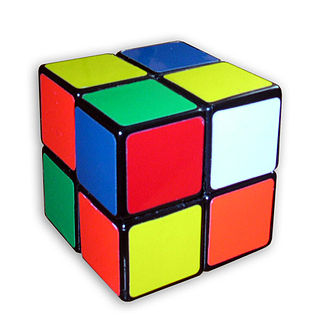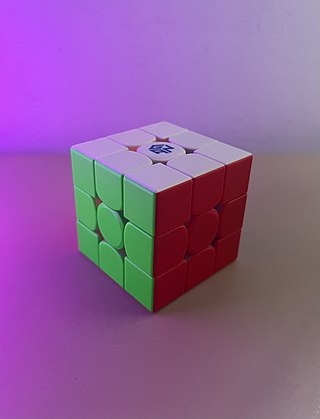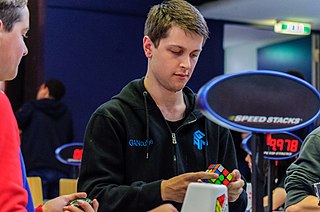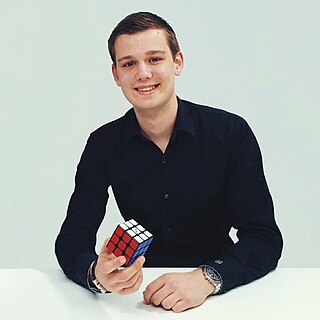Related Research Articles

The Rubik's Cube is a 3-D combination puzzle originally invented in 1974 by Hungarian sculptor and professor of architecture Ernő Rubik. Originally called the Magic Cube, the puzzle was licensed by Rubik to be sold by Pentangle Puzzles in the UK in 1978, and then by Ideal Toy Corp in 1980 via businessman Tibor Laczi and Seven Towns founder Tom Kremer. The cube was released internationally in 1980 and became one of the most recognized icons in popular culture. It won the 1980 German Game of the Year special award for Best Puzzle. As of March 2021, over 450 million cubes had been sold worldwide, making it the world's bestselling puzzle game and bestselling toy. The Rubik's Cube was inducted into the US National Toy Hall of Fame in 2014.

The Rubik's Revenge is a 4×4×4 version of the Rubik's Cube. It was released in 1981. Invented by Péter Sebestény, the cube was nearly called the Sebestény Cube until a somewhat last-minute decision changed the puzzle's name to attract fans of the original Rubik's Cube. Unlike the original puzzle, it has no fixed faces: the center faces are free to move to different positions.

The Pocket Cube(also known as the2×2×2 Rubik's Cube or Mini Cube) is a 2×2×2 version of the Rubik's Cube. The cube consists of 8 pieces, all corners.

Minh Thai is a Vietnamese-American speedcuber. As a sixteen-year-old Eagles Rock High School student from Los Angeles, he won the first world championship on June 5, 1982 in Budapest by solving a Rubik's Cube in 22.95 seconds. He is also the author of the book The Winning Solution (1982), a guide to solving the cube. Later, Ortega Corners-First Solution Method for Rubik's Cube is based on Minh Thai's Winning Solution.

Speedcubing is a competitive sport that involves solving a variety of combination puzzles, the most well-known of which is the 3x3x3 puzzle, as quickly as possible. A person who competitively solves combination puzzles is called a speedcuber, or a cuber. To solve most puzzles, one must perform algorithms in a series in order to solve the puzzle.

The Professor's Cube is a 5×5×5 version of the original Rubik's Cube. It has qualities in common with both the 3×3×3 Rubik's Cube and the 4×4×4 Rubik's Revenge, and solution strategies for both can be applied.

Rubik's Clock is a mechanical puzzle invented and patented by Christopher C. Wiggs and Christopher J. Taylor. The Hungarian sculptor and professor of architecture Ernő Rubik bought the patent from them to market the product under his name. It was first marketed in 1988.
Jessica Fridrich is a professor at Binghamton University, who specializes in data hiding applications in digital imagery. She is also known for documenting and popularizing the CFOP method, one of the most commonly used methods for speedsolving the Rubik's Cube, also known as speedcubing. She is considered one of the pioneers of speedcubing, along with Lars Petrus. Nearly all of the fastest speedcubers have based their methods on Fridrich's, usually referred to as CFOP, that is,.

The World Cube Association (WCA) is the worldwide non-profit organization that regulates and holds competitions for mechanical puzzles that are operated by twisting groups of pieces, commonly known as twisty puzzles. The most famous of those puzzles is the Rubik's Cube. The WCA was founded by Ron van Bruchem of the Netherlands and Tyson Mao of the United States in 2004. The goal of the World Cube Association is to have "more competitions in more countries with more people and more fun, under fair conditions." In 2017, they started work to become a non-profit organization and on November 20, 2017, the state of California accepted the initial registration of the World Cube Association.
The CFOP method, also known as the Fridrich method, is one of the most commonly used methods in speedsolving a 3×3×3 Rubik's Cube and is possibly the fastest method. This method was first developed in the early 1980s combining innovations by a number of speed cubers. Czech speedcuber and the namesake of the method Jessica Fridrich is generally credited for popularizing it by publishing it online in 1997.
Bob Burton is an American speedcuber, most famous for competing in and organizing competitions all over the world and his former world records on the Rubik's Magic and Rubik's Master Magic.

Ron van Bruchem is a Dutch speedcuber living in Hilversum. He helped create the current resurge of Rubik's Cube enthusiasm by founding the international speedcubing community and organizing international competitions. He is also a founder, delegate and former chairman of the World Cube Association, an organization aiming at the spread of speedcubing as a regulated sport. He is also the host of the website speedcubing.com.
Eric Limeback is a Canadian speedcuber. He is known for his 11/11 3x3x3 multiblindfold Canadian record solve, as well as his standard 3x3x3 blindfolded solving. Limeback was the first Canadian to record a sub-30 second official 3x3x3 blindfolded solve. Limeback began solving the Rubik's Cube in 9th grade. He graduated from Marc Garneau Collegiate Institute in 2010. He formerly held the Guinness World Record for the most 3x3x3 cubes solved in 24 hours, 5800, set from 3–4 October 2013 at Wilfrid Laurier University, Canada.

Feliks Aleksanders Zemdegs is an Australian Rubik's Cube speedsolver. He is one of the only two speedcubers ever to win the World Cube Association World Championship twice, winning in 2013 and 2015, and is widely considered the most successful and greatest speedcuber of all time. He has set more than 350 records across various speedcubing events: 121 world records, 211 continental records, and 6 national records.

Anthony Michael Brooks is an American speed cubing champion. He specializes in the 2x2 cube and classic 3x3 cube, and has been officially ranked in the top five in the world in both categories as recognized by the World Cube Association. Since learning to solve the cube in March 2008, Brooks has become known for developing advanced speedsolving methods as well as frequently promoting speedcubing in the media. While working as the Liberty Science Center's Speedcuber-in-Residence, Brooks set the Guinness World Record for most Rubik's Cubes solved underwater in a single breath, and also led the team that currently holds the world record for solving the Groovik's Cube, the world's largest functioning Rubik's Cube. In July 2017, Brooks was featured on the debut season of FOX's Superhuman TV show.

The 1982 World Rubik's Cube Championship was a competition for speedsolving the 3×3×3 Rubik's Cube.
Gilles Roux is a French speedcuber primarily known for inventing a 3x3x3 Rubik's Cube method, the Roux Method, and achieving fast times with it.

Mats Valk is a Dutch Rubik's Cube speedsolver. He broke the Rubik's cube single solve world record twice with times of 5.55 seconds in 2013 and 4.74 seconds in 2016. He won the Rubik's Cube European Championship in 2018 and was runner-up for 3x3x3 at the Rubik's Cube World Championships in 2013 and 2015.

Kevin Hays is a former professional American Rubik's Cube speedcuber. Recognized as an expert at solving big cubes, he has won 6 world championship titles and set 21 world records across the three events. He has also set 47 North American records and won 21 US National titles.
Max Park is an American Rubik's Cube speedsolver, widely considered as one of the greatest cubers of all time. He is the World Champion of 3×3×3 solving and world record holder for the 3x3x3 single solve at 3.13 seconds set on June 11, 2023. He is one of the only two speedcubers ever to win the World Cube Association World Championship twice. Winning in 2017 and 2023. He is currently tied for 2nd place for the world record average of five 3×3×3 solves at 4.86 seconds, set on 6 February 2023. Park first held this record from April 23, 2017 to June 28, 2017 and was the only cuber other than Feliks Zemdegs to hold the record between September 27, 2009 and June 5, 2021. Park has also set multiple world records in speedsolving in the 4×4×4, 5×5×5, 6×6×6, and 7×7×7 cubes as well as the 3×3×3 One-Handed event. As of September 2, 2023, he has won 479 total events in World Cube Association competitions. As of 2023, his main [3×3 cube] is the HuaMeng YS3m which he has gotten many exceeding averages.
References
- ↑ Team, WCA Website. "World Cube Association - Official Results". www.worldcubeassociation.org. Retrieved 2016-01-31.
- ↑ "'Speed cubers' flock to Hilton Head for national Rubik's Cube championships". islandpacket. Retrieved 2016-01-31.
- ↑ CubingUSA. "US Nationals 2016 - Rubik's Cube Competition". www.cubingusa.com. Retrieved 2016-01-31.
- ↑ News, Stanford. "Stanford represented at national Rubik's Cube competition | The Dish". news.stanford.edu. Retrieved 2016-01-31.
{{cite web}}:|last=has generic name (help) - ↑ "World Cube Association Regulations Committee - Speedsolving.com Wiki". www.speedsolving.com. Retrieved 2016-01-31.
- ↑ Cal student & CGB writer Vincent Sheu solves Rubik's Cube on ESPN , retrieved 2016-01-31
- ↑ "VIDEO: Student does Rubik's Cube during Cal-Stanford". CBSSports.com. Retrieved 2016-01-31.
- ↑ "Vincent Sheu - Speedsolving.com Wiki". www.speedsolving.com. Retrieved 2016-01-31.
- ↑ Venkataraman, Bina (2008-12-15). "Jessica Fridrich Specializes in Problems That Only Seem Impossible to Solve". The New York Times. ISSN 0362-4331 . Retrieved 2016-01-31.
- ↑ Team, WCA Website. "World Cube Association - Official Results". www.worldcubeassociation.org. Retrieved 2016-01-31.
- ↑ Team, WCA Website. "World Cube Association - Official Results". www.worldcubeassociation.org. Retrieved 2016-01-31.
- ↑ Team, WCA Website. "World Cube Association - Official Results". www.worldcubeassociation.org. Retrieved 2016-01-31.
- ↑ Cal student & CGB writer Vincent Sheu solves Rubik's Cube on ESPN , retrieved 2016-01-31
- ↑ "VIDEO: Student does Rubik's Cube during Cal-Stanford". CBSSports.com. Retrieved 2016-01-31.
- ↑ "@johnbreech Video of a Cal student solving a Rubik's Cube behind ESPN booth". Mobypicture. Retrieved 2016-01-31.
- ↑ Blogs, California Golden. "Cal student & CGB writer Vincent Sheu solves Rubik's Cube on ESPN". www.chatsports.com. Retrieved 2016-01-31.
- ↑ Cal Bears (2014-02-27), Cal Men's Basketball: The Rubik's Cube , retrieved 2016-01-31
- ↑ Through the Wormhole, 2010-06-09, retrieved 2016-01-31
- ↑ "Through the Wormhole with Morgan Freeman: Season 5 Episode 8 | LocateTV". LocateTV.com. Retrieved 2016-01-31.
- ↑ "High expectation Asian father is proud on this day • /r/funny". reddit. Retrieved 2016-01-31.
- ↑ "Stanford Basketball: Students Study During UCLA Game With Rubik's Cube (PHOTO) - Lost Lettermen". Lost Lettermen. Retrieved 2016-01-31.
- ↑ "Caption Contest: Law School Ruins Sporting Events". Above the Law. Retrieved 2016-01-31.
- ↑ "Caption Contest Finalists: Law School Ruins Sporting Events". Above the Law. Retrieved 2016-01-31.
- ↑ "Caption Contest Winner: Law School Ruins Sporting Events". Above the Law. Retrieved 2016-01-31.
- ↑ News, Stanford. "Stanford represented at national Rubik's Cube competition | The Dish". news.stanford.edu. Retrieved 2016-01-31.
{{cite web}}:|last=has generic name (help) - ↑ "DeCal: How to Solve the Rubik's Cube/Speedcubing Decal". DeCal. Retrieved 2019-10-24.
- ↑ "Vincent S Profile, Activity and Communities". www.sbnation.com. Retrieved 2016-01-31.